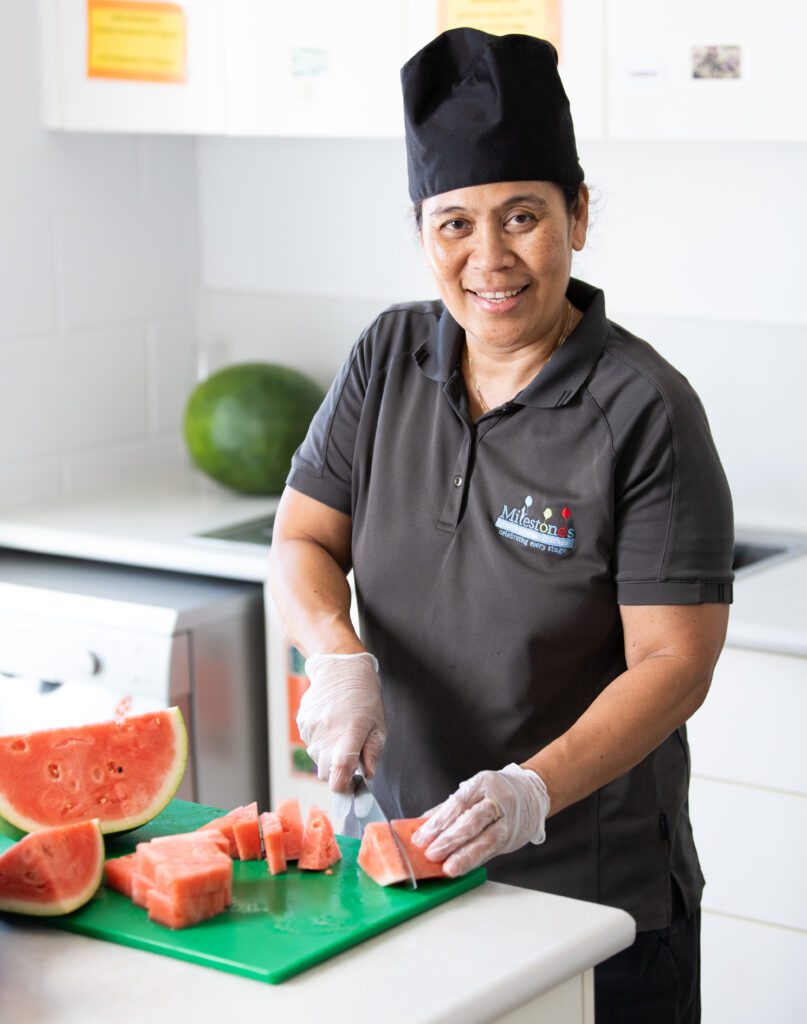
Food exploration in a positive environment shows a reduced risk of children becoming picky eaters.
Research shows that introducing new foods to your child within the first two years and before age four is crucial in nurturing a love of healthy and diverse food and eating habits.
Providing your child with the opportunity to try new foods or foods they have previously refused in a fun way, can increase the likelihood of your child becoming more open and accepting of new and exciting healthy options.
Don’t feel discouraged if your child is persistent with their fussy eating habits, Aussie Kindies Early Learning Stanthorpe’s Centre Cook, Petrisse Redge, stated, “Picky eating is somewhat of a rite of passage for most children. It is not uncommon when children start at our centre to have some apprehension when it comes to mealtimes, but fortunately, this doesn't last long.”

How our centre’s facilitate food exploration
At Affinity owned and operated centres that provide food, we offer healthy meal/snack options within a fun and safe environment, allowing children to experience and explore the different tastes, smells and textures of food.
Throughout all Affinity centres nationally, we abide by a strict food allergy policy whereby all meals/snacks provided are curated to the specifications of the children in their centre and in line with feedAustralia.
Kim Dennison, Centre Cook for Papilio Early Learning Robina, and 2022 Affinity Award Winner for Best Centre Cook provided some great insight into how she works to reduce fussy eating habits. Kim noted the best way to assist in creating well-rounded happy eaters is to introduce a range of food as early as possible and be persistent. She goes on to add that the most important thing is to use no additives or pre-packaged foods like McDonalds due to the excessive sugar and salt. This food also does not expose children to different flavors and textures.
Kim further explained, “My favorite way to get children to try new foods is to get them involved in the process including shopping and cooking – they love to be a part of making their own meals. Use positive reinforcement with the children who eat and try new foods to encourage their friends to follow suit. In doing so, this helps to highlight a healthy relationship with food.
"Cooking with children is not just about ingredients, recipes, and cooking. It's about harnessing imagination, empowerment, and creativity,” Kim said.

Jola Sung, Senior Education Advisor for Affinity Education shared, “Our Lifelong Learning Curriculum promotes ‘Completely Connected zones’ in our classrooms. We consider our meal areas as a place where our Educators are completely connected with children – where they can share their love for healthy eating together. There are many opportunities to support food education in a child's daily routine, so our Educators, supported by Affinity’s Education Team, value this dedicated practice in our curriculum each and every day.”
Our centre experiences may include:
- Creating mealtime environments focused on patience, fun and understanding.
- Facilitating a range of programs that cover food groups, where food comes from and the importance of hygiene around food.
- Exploring the process of garden to table, through growing their own food in our centre gardens and then being a part of the process of cultivating, preparing and then eating the food they have grown.
- Cooking lessons where children assist our qualified team with preparing their meal/snack which assists with practicing patience, sharing and motor skills.
- Providing self-selection platters for children to try new and exciting food groups at their own pace.
- Allowing children to show and discuss the meals they have brought from home and why they enjoy what they have, encouraging open discussions around food.
- Reading storybooks relating to food and engaging with children in discussions around healthy food and 'sometimes' food.
Aussie Kindies Early Learning Stanthorpe, Centre Cook, Petrisse Redge, continued, “In our centre we focus on making mealtimes as much fun as possible, while also being patient and guiding during these experiences.
“We often refer to the term ‘eat a rainbow’ this comes into play during planning menu’s, ordering food and most importantly during mealtimes. The children love the term ‘eat a rainbow’ and this is one of the greatest tools we use to help the children understand healthy eating, as well as make healthy food selections.
“During the first couple of visits parents will often comment on the food on our centre menus that they think their child will not eat. We will often reassure our families that children are a lot more likely to try new foods if all their friends are trying it too” Petrisse said.
Petrisse Redge, continued, “Making mealtimes enjoyable and fun is the best way to get children who are picky eaters to try new foods. Nearly every meal at our centre is served on platters so that the children can serve themselves for meals. We also incorporate play into mealtimes, by making morning and afternoon teas that are fun and interactive. Some of the children’s favourite mealtime play includes building vege bugs and DIY ants on a log.
“One of my favourite experiences is that we had a child who would come into the centre and say, ‘it stinks in here!’ (We are lucky enough to have an open kitchen in our foyer, so the smells of every meal waft through the centre).
“Shortly after, the same child came running up to the gate in the kitchen to ask what they would be eating that day. I believe through the strategies our amazing educators implement during mealtimes and the children having positive experiences when it comes to food, our children become adventurous and confident eaters.” Petrisse Said.

How you can assist with food exploration at home
We understand that mealtimes can be tough when you have a fussy eater.
Some of our top tips that may help you in introducing new food or meals into your child’s diet are:
- Creating a relaxed and engaging environment for mealtimes, and to try and minimise the amount of pressure or fuss on your child to eat the food they are refusing.
- Introduce new foods as early as you can safely, and once old enough try to encourage your child to eat the same meals as you do.
- Get your child involved in preparing their own meals! Have them assist with preparing, serving, or even finding recipes for you to make.
- Let your child play and explore with their food! Allowing your child to explore food can be a little messy but it also allows them to try the food in their own time and familiarise themselves with different tastes, smells and textures.
- Ensure that your centre knows how you respond at home if your child is refusing to eat certain foods. This allows your child's Educators to adapt a similar and consistent approach (where possible) in the centre.
- Try to avoid providing replacement meals too quickly. If they state they are hungry later on, offer the same meal again with encouragement and role modelling.
- Consistency is key, even making small progress is progress, and over time you will start to see the difference in your child’s relationship with food.
- Present the food in different ways, i.e., mashed instead of steam veggies so children can still be exposed to a variety of healthy food.
For more information about your closest centres book a tour or call our Family Support Team on 1800 CHILDCARE.
For more information on how to deal with fussy eaters please see the additional sources below:
